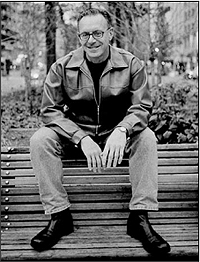"Young men have a passion for regarding
their elders as senile."
-Henry Brooks Adams. The Education of
Henry Adams. (1907) |
|
|
Ross Gardiner, an up-and-coming young business
executive, is sentenced to six months of community service visits to Mr. Green, the elderly man he nearly ran down with his car.
However, Mr. Green does not welcome the young man's services, for he has lived as a virtual recluse since his wife died.
Full of preconceived prejudices and resentments, he does not appreciate Ross' attempts to clean up the clutter of his
Upper West Side Manhattan apartment as well as mess with his memories.
As Ross organizes, there is evidence of cracks in Mr. Green's narrow-minded and suspicious veneer while Ross gains fatherly support in his own emotional struggle.
The play is full of humor as it explores the nature of human understanding, tolerance and forgiveness.
"If i am not for myself, who shall be for
me?
If i am for myself, what am i?
If not
now, when?"
-Hillel. The Wisdom of the Fathers |

Originally from New Jersey, Jeff Baron earned his degree in film production at Northwestern, an M.B.A. from Harvard and left a successful corporate career to be a writer. His first play, Visiting Mr. Green, a 1998 Drama League Best Play nominee, enjoyed a long and successful run Off Broadway at New York's Union Square Theatre with Eli Wallach in the title role. It also has had successful productions worldwide. Baron wrote the libretto for Escape, an original opera commissioned by the Los Angeles Opera, and directed the world premiere of the comic opera Song of Martina at Carnegie Hall, which he and Dean X. Johnson wrote. For television he wrote for "The Tracey Ullman Show" and "A Year in the Life." His film The Bruce Diet won the CINE Golden Eagle award. He is currently working on a new play.
Mr. Green keeps a kosher home and is very concerned when Ross brings in food from the outside.
Kosher has a threefold meaning:
1. generally means fit or proper,
2. refers to foods that can be eaten in accordance to Jewish dietary laws,
and
3. refers to the separation of milk dishes from meat.
If something is not kosher, then it is traif, meaning it is food that does not fit Jewish dietary laws or is a utensil which may have become unfit for use.
Short Humorous Summary
of every Jewish Holiday:
"They tried to kill us,
we won,
let's eat! |
|
|
The laws relating to keeping kosher are called kashrut and are derived from Biblical passages. In "Leviticus" 11:1-43 Jews are informed as to which animals, fish and fowl are regarded as appropriate to eat. "Leviticus" 20:25-26 states, "So you shall set apart the clean beast from the unclean... You shall be holy to Me, for I the Lord am holy." From this perspective, kashrut is seen as a commandment from God. Another viewpoint about kashrut is that through the observance of these laws, Jews exercise and hopefully gain control over one of the basic activities of life-preparing and eating food. Such self-control is viewed as a form of personal growth and a mastery over one's life.
All vegetables and fruit are kosher and can be eaten at any meal. Any variety of fish that has both fins and scales is kosher, but shellfish (shrimp, lobster, crab, oysters, clams) are not. In addition, such exotic animals as eel, shark, porpoise and whale are forbidden. Domestic fowl are kosher and include chicken, turkey, tame ducks and tame geese. However, they must be ritually slaughtered by a person specifically trained and authorized to do this: a shohet. All animals that both chew their cud and have a split hoof are kosher; these include cows, sheep and goats. Animals that are traif include horses, donkeys, camels and pigs. As with fowl the animals must be properly slaughtered and must be koshered-soaked and salted to remove excess blood. A kosher butcher can perform this service, but many observant Jewish women do it themselves.
In keeping a kosher home, one must observe
Milshik refers to any food that is or contains milk or any product derived from a milk substance. Fleishik is any food that contains meat or meat by-products or derivatives. Thus, one may eat roast beef for dinner, but cannot have ice cream for dessert. As in Mr. Green's home, separate sets of dishes and silverware must be maintained for this practice. If a milshik plate is used for meat, then it must be thrown away. Because glass is a nonporous material, it is home free and can be used with both milk and meat.
As do many other religions, Judaism condemns the sexual act between males, taking as proof the text in "Leviticus" 19:22,
"Thou shalt not lie with mankind, as with womankind; it is an abomination." However, over the centuries other viewpoints have evolved.
The Orthodox Jews, the most religious and traditional branch, forbids homosexual relations. They also condemn the establishment of so-called "gay synagogues", for that would place the mantle of respectability upon a relationship that is
"an act of Jewish self-destruction."2
However, homosexuals are to be welcomed into the Jewish community or congregation because
"a Jew remains a Jew, no matter how serious his sin."3
| |
Faygeleh: 1. little bird 4. homosexual. Quite common in the
American-Jewish vernacular. A
synonym for the English "fairy"
or "fag." most Jews use the
word as a discreet way of
describing a homosexual, especially when they might be overheard.
-Leo Rosten
1 |
|
Conservative Judaism, while not defined, would probably retain the traditional perspective. But Conservative leaders urge more tolerance, acceptance and understanding of gays so that they become a part of
synagogue life and do not feel they must establish their own house of worship. In fact, Conservatives will grant homosexuals almost any role in the community except that of adoptive or foster parents and/or religious leader.
The Reform congregations were among the first to recognize civil rights and liberties for gays and to welcome them into houses of worship, both as members and religious leaders. In addition, they also support gay synagogues such as Beth Chayim Chadashim (House of New Life) in Los Angeles, the first homosexual congregation in the United States and one with a gay rabbi. The congregants were insistent on this issue because they felt only a homosexual rabbi would understand the problems of a gay community.
In a 1989 address to the Union of American Hebrew Congregations, Rabbi Alexander M. Schindler reminded his organization of Jewish history. In recalling the Holocaust, the hidden Jews of Spain during the Inquisition (Marranos), and the pogroms of Eastern Europe, the rabbi urged Jews to give homosexuals
"a place where loneliness and suffering and exile can end–and a place where we can search together–to find those affirmations for which we yearn."4
From the earliest period of Jewish history, the question of intermarriage has been a highly-charged issue for some Jewish families but not so for others.
| |
MR. GREEN: "Rachel married
a goy. she's dead."
-Visiting Mr. Green |
|
For example, in "Genesis" 24 Abraham worried about it and made his servant Eliezar swear that, in finding a wife for his son Isaac,
"you will not take a wife for my son from the daughters of the Canaanites."
It was a problem for Rebekeh, too, in "Genesis" 27:46 when she exclaimed,
"If Jacob takes a wife of the daughters of Heth-what good shall my life do me?"
In contrast, Jacob kept calm when, in "Genesis" 34, he accepted the possibility that his daughter, Dinah, might marry a non-Jew named Shechem. And Jews do celebrate the holiday of Purim when Esther, who was married to King Ahasuerus, also not Jewish, outwitted the deceits of Haman and saved her people. Her marriage gave her brother Mordecai no concern.
However, according to religious Jewish law the
"marriage of a Jew with a non-Jew has no binding force-and is not recognized as religiously valid even if performed and blessed by a hundred rabbis."1
As contact between Jews and non-Jews increased, so did intermarriage, a union that the Jewish community regarded with distress and sorrow. If a family member married a goy (a non-Jew), often the immediate relatives would observe "shivah," the actual mourning rites, for they considered that person dead-cut off from the living Jewish community. The vast majority of North American Jews no longer take such a harsh view of intermarriage; however, most Jewish parents and grandparents try to discourage their children from marrying a person of another religion.
"Gentiles are not used to
Jewish problems."
-Folk saying |
|
|
Today, intermarriage concerns Jews because it is seen as a threat to Jewish survival. The Holocaust annihilated nearly one-third of the world's Jewish population while the low birth rate and assimilation keep the numbers at below replacement levels. Because Jews live in an open egalitarian society, intermarriage has become problematic.
Most rabbis refuse to marry a Jew and a non-Jew because it is contrary to the tradition of Jewish religion. However, a minority of rabbis disagree, contending the marriage will take place anyway and it is best not to drive the couple away completely.
Recognizing that their members may hold divergent views, the Central Conference of American Rabbis (CCAR) has offered options:
1) provide opportunities for the non-Jewish spouse to convert,
2) assist in educating children of such mixed marriages as Jews, and
3) encourage a cultivation of involvement in the Jewish community and synagogue.
| Shabbos: |
Sabbath |
| Bris: |
the ceremonial circumcision of Jewish males eight days after birth. |
| Pesach: |
the Jewish holiday of Passover celebrated in the spring to commemorate the end of
bondage in Egypt and the passage through the desert led by Moses. |
| Kistinev: |
a Jewish shtetl (village) in Moldavia, part of the Pale of Settlement.* |
| Mazeltov: |
Congratulations! |
| Pinsk: |
a village in Bielorussia that was part of the Pale of Settlement.* |
| Yarmulke: |
the skullcap worn by Jewish males. |
| Tallis: |
prayer shawl worn by Jewish males at prayer and religious services. |
| Dahvening: |
praying. |
Mein sheina
maydelach: |
my pretty little girl.
|
*Czarina Elizabeth II established the Pale of Settlement in 1791 as a territory for Russian Jews to live.
Judaism condemns suicide as a violation of the life given by God, because God has the right to determine when life should end.
The chief Biblical source prohibiting it is the commandment
"Thou shalt not kill."
The Lower East Side is the neighborhood in Manhattan bounded to the north by 14th Street, to the east by the East River, to the south by Fulton and Franklin streets, and to the west by Pearl Street and
Broadway. It encompasses Ludlow Street where Mr. Green once lived, as well as such areas as the East Village, Chinatown, Little Italy, Tompkins Square and Astor Place.
Some of the first settlers were free black farmers who settled around the Bouwerie (Bowery). In 1833, Irish immigrants settled in the first tenements built in the northern section; the Germans and Dutch developed the area north of Houston Street in the 1840s. The 1880s saw the influx of Italians, Jews, Russians, Rumanians, Hungarians, Ukrainians, Slovaks, Greeks and Poles. One of the largest ethnic enclaves was the Jewish one that had a
population of 400,000 by 1920. Living in overcrowded tenements with poor sanitation and rampant poverty, the neighborhood, nevertheless, became known for its artists and radical politics. The Henry Street Playhouse opened in 1915 and spawned such talents as Eddie Cantor, George and Ira Gershwin, Irving Berlin, Jimmy Durante, Al Jolson and the Marx Brothers. After World War II, the area became the first racially integrated section of the city with the influx of African Americans and Puerto Ricans.
The Upper West Side, where Mr. Green lives now, is a neighborhood in Manhattan lying on a rugged plateau bounded to the north by 125th Street, to the east by Central Park, to the south by 59th Street and to the west by the Hudson River. Before the American Revolution many successful merchants, lawyers and British officials had country homes there; after the Revolution the property of the Tories was confiscated. In the early 19th century small villages were formed which interspersed with the estates of wealthy merchants, financiers and professionals. After the completion of Central Park in the 1850s, row houses were built in distinctive architectural styles on West End Avenue from about 70th Street to the lower 80s. Many large residential hotels soon lined Central Park West. Such establishments as Columbia University, the Cathedral of St. John and the American Museum of Natural History are located in this area.
The advent of rapid transit in 1904 spurred the construction of apartment buildings well into the 1930s. Developers hoped the new residents would be prominent and wealthy; instead they were people in the arts, theatre, literature, advertising, sports, politics and crime. From the Great Depression of 1929 to the late 1970s the population was made up mostly of the middle and working class. From 1950 to 1980 several projects were built, including large mixed-housing complexes, the New York Coliseum and the Lincoln Center for the Performing Arts. The neighborhood became more attractive to affluent couples and
single people who flocked there drawn by the cultural renaissance of the area, its social tolerance, political activism and neighborhood "feeling." The inflated price of fine brownstones and pre-war apartments drove out many members of the middle class who could no longer afford the escalating rents.
1. Why does Mr. Green cling to his faith while
Ross Gardiner does not?
Is it pressure from
modern society? |
|
2. How do you feel about inter-religion marriage?
How does your family feel?
What is
your religion's point of view? |
3. How do you feel about inter-racial marriage? How does your family feel?
What is
your religion's point of view? |
|
4. How do you feel about the "punishment"
Ross was given for nearly running down Mr.
Green?
Was it too harsh?
What seems fair? |
| 5. Interview an older person about what life
was like when they were growing up. Ask
about schools, games, entertainment, courting
rituals, leisure time activities, etc. |
|
6. What could you give to an older person that
they might need, desire, enjoy?
ex. time, help,
etc. |
7. What could an older person give to you that
you might need, desire, enjoy?
ex. perspective,
experience, expertise, ideas, understanding. |
|
8. List some adjectives for Mr. Green.
For
instance, things like lonely, isolated, immobile, forgetful, stubborn. |
9. List some adjectives for Ross.
For instance,
things like young, impatient, frustrated, hurried, kind, caring. |
|
|
Sources (The Kosher Home)Siegel, Richard; Strassfield, Michael; Strassfield, Sharon.
The Jewish Catalog. Philadelphia: The Jewish Society of
America, 1973
Notes & Sources (Judaism and Homosexuality)
Goldman, Alex J. Judaism Confronts Contemporary Issues.
New York: Shengold Publishers, 1978.
Jacobs, Louis. What Does Judaism Say About-----?
New
York: New York Times Book Co., 1973.
Rosten, Leo. The Joys of Yiddish.
New York: Pocket Books,
1970.
Vorspan, Albert and Saperstein, David. Jewish Dimensions
of Social Justice.
New York:
Union of American Hebrew Congregations Press, 1998.
1. Rosten, p. 115
2. Goldman, p. 203
3. Goldman, p. 203
4. Vorspan and Saperstein, p. 349
Notes & Sources (Intermarriage)
Donin, Rabbi Hayim Halevy. To Be a Jew.
New York: Basic
Books, Inc., 1972.
Polish, Daniel F.; Syme, Daniel B., and Zlotowitz, Bernard
M. What Does Judaism Say?
New York: Union of American
Hebrew Congregations Press, 1991.
Vorspan, Albert and Saperstein, David. Jewish Dimensions
of Social Justice.
New York: Union of American Hebrew
Congregations Press, 1998.
1. Donin, p. 29
Sources (Glossary of Jewish Terms and Jewish Views on Suicide)
Goldman, Alex J. Judaism Confronts Contemporary Issues.
New York: Sheingold Publishers, 1978.
Rosten, Leo. The Joys of Yiddish.
New York: Pocket Books, 1970.
Sources (Places in the Play)
Jackson, Kenneth T., ed. The Encyclopedia of New York
City.
New Haven: Yale University Press, 1995.
This study guide was originally produced by the Marketing Department of the Denver Centre Theatre Company.
The Harold Green Jewish Theatre Company would like to thank them for the use of this material.













